
I hate shopping. Which is why I stopped in Starbucks the other morning to review (non-existent) progress on my ‘list’.


I hate shopping. Which is why I stopped in Starbucks the other morning to review (non-existent) progress on my ‘list’.
“To paraphrase an old industry saying about IBM…
Google’s not the competition, Google’s the environment.”
Rich Skrenta, co-founder and CEO of Topix.net, in a fascinating post arguing that Google’s real market share is closer to 70% than the fortysomething per cent habitually cited by market researchers.
There’s a certain predictability about this. According to John Markoff in the New York Times…
Microsoft is facing an early crisis of confidence in the quality of its Windows Vista operating system as computer security researchers and hackers have begun to find potentially serious flaws in the system that was released to corporate customers late last month.
On Dec. 15, a Russian programmer posted a description of a flaw that makes it possible to increase a user’s privileges on all of the company’s recent operating systems, including Vista. And over the weekend a Silicon Valley computer security firm said it had notified Microsoft that it had also found that flaw, as well as five other vulnerabilities, including one serious error in the software code underlying the company’s new Internet Explorer 7 browser.
The browser flaw is particularly troubling because it potentially means that Web users could become infected with malicious software simply by visiting a booby-trapped site. That would make it possible for an attacker to inject rogue software into the Vista-based computer, according to executives at Determina, a company based in Redwood City, Calif., that sells software intended to protect against operating system and other vulnerabilities…
Anthony Seldon had an extraordinary piece about Tony Blair in the Guardian. The headline — “Whatever the Brownites say, history will judge Blair as a political colossus” — says it all. Andrew Rawnsley — typically — tries to have it both ways in this morning’s Observer, arguing that while Blair has been a disaster, he will get his ten years in Downing Street and thereby join a select Pantheon whose other members are Robert Walpole, Henry Pelham, Lord North, William Pitt, Lord Liverpool, William Gladstone, Lord Salisbury and Margaret Thatcher.
David Marquand has written an elegant riposte to this baloney. It reads, in part,
Iraq was not a minor peccadillo, as Seldon seems to think. It was a monumental, unmitigated disaster, for which Blair is as much to blame as Bush. The shabby tergiversations of the run-up to the war – the misuse of intelligence, the contempt for expert opinion, the disdain for international law and the collusion with the United States in shutting down the Blix investigation of alleged Iraqi WMD – were venial in comparison with the sequel. The endemic conflicts of the Middle East are more explosive than they were. Jihadist extremism is more widespread and more bloodthirsty.
Iraq itself is slithering into civil war. Iran’s rise to regional super-power status has received an enormous boost. The chances of a just settlement of the Israeli-Palestinian crisis are smaller. Innocent British civilians are in greater danger. And all of this was entirely predictable. The charge against Blair is not so much that he acted illegally and immorally (though he did) as that he hitched his wagon to a US administration of swivel-eyed fanatics, consumed by a messianic fever and utterly ignorant of the realities of one of the most complex regions in the world. It was worse than a crime. It was a blunder for which we shall pay even more dearly in future than we have already.
So why did he do it? It would take a psychiatrist to answer that question fully. But two preliminary answers stand out. The first is that the flip side of Blair’s magical persuasive abilities is, and always has been, an extraordinary capacity for self deception. As Seldon’s own biography of him shows, he has always been apt to mistake his wishes for facts. Like the great actor he is, he lives whatever part he is playing; and if reality gets in the way, so much the worse for reality. The second answer is simpler. Like many people who have been at the top for to long he has succumbed to hubris. The bad news is that nemesis has struck his country as well as himself. The good news is that a merciful release is on its way.
I plump for the second explanation. Indeed I wrote about it last year. All Prime Ministers go mad, eventually, and the longer they server, the madder they become.

Disconsolate punt-chauffeurs on the river Cam this morning.

Sacre Bleu! A British bank paying attention to its customers. Whatever next?
Photographed in Cambridge this (Saturday) morning.
I’m slow on the uptake — which is why I’m only the 11,940,745th person to discover this, but it’s terrific An anonymous kid playing an amazing set of variations on Pachelbel’s Canon in D Major.
And yes, I did mean 11.9 million btw. Isn’t the Web wonderful.
From today’s New York Times…
The controllers communicate with the Wii console, a $250 box no larger than a child’s lunchbox, with the wireless technology known as Bluetooth. It is the means commonly used to link cellphones with their wireless headsets. The Wii remote also uses infrared, the same technology that links television sets with their remote controllers, to track where the controller is pointed.
In this case, a sort of crude camera — an image sensor — in the forward tip of the remote (the primary controller) detects tiny light-emitting diodes in a “sensor bar” that must be set on or very near a television plugged into the Wii. This system helps players use the remote to point accurately at specific things on the screen, like the virtual buttons to begin or end a game, or aim a weapon in a game.
Actions like pressing the buttons on screen or firing a weapon are conveyed between Bluetooth chips in the remote and in the console. The remote also contains a rumble pack, a component that vibrates to varying intensities based on information the console draws from the game’s programming and then passes to the controller.
But the controller’s most-talked-about feature is the capacity to track its own relative motion. This enables players to do things like steer a car by twisting the remote in the air or moving a game character by tilting the remote down or up.“
This represents a fabulous example of the consumerization of MEMS,” the tiny devices known as micro-electro-mechanical systems, said Benedetto Vigna, general manager of the MEMS unit at STMicroelectronics, a leading maker of the accelerometers embedded in the controllers. (Nintendo itself declined to talk about the controllers’ inner workings.)
He said the motion sensors, using the technology that activates vehicle air bags, can accurately sense three axes of acceleration: up and down, left to right, and forward and backward.
This is mostly achieved within the MEMS, micron-size machines that depend on submicroscopic structures carved into the silicon. For example, one structure moves like a tiny diving board, stimulated by the actions of the game players.
The structures are enveloped in an electrical field, Mr. Vigna said. When the MEMS elements are moved, the electrical field changes and the MEMS chip is sensitive enough to detect the changes. These accelerometers are so sensitive, Mr. Vigna said, because electrons — those subatomic particles that whirl around the nucleus of atoms like a video game in the making — can sense the subtle atomic-level movement of the silicon structures.
What’s amazing about the Will controller, is the elegance with which all this complicated stuff has been implemented and packaged. No wonder people are queueing up to buy it.

In a comfortable armchair, surrounded by all those books that Amazon delivered but one hasn’t yet had time to read.